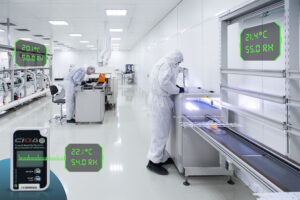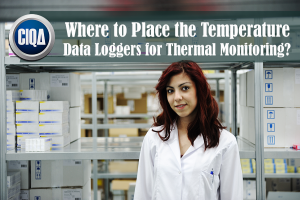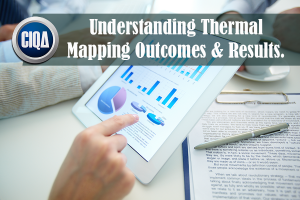Make a Cleanroom Validation in compliance with ISO14644
|
The validation of the cleanroom shall demonstrate that the production area (in which your products and components shall be exposed to the environment during its manufacturing process) is suitable and appropriate under acceptable conditions and parameters of the design in compliance with the international organization ISO under standard ISO14644.
The cleanroom validation protocol may include the following (14) challenges and testing activities:
- Room Temperature
- % Relative Humidity
- Viable particulate – surface
- Viable particulate air
- Non-Viable particulate
- Pressure Differential
- HEPA Filter Integrity
- HEPA Filters Velocities
- Room Air Changes
- Room Air Balance CFMs
- Smoke Test – Airflow pattern
- Particle Decontamination Test
- Recovery Test – AHU shut down
- Sound and Lighting Test
Additional criteria to be considered which affects room cleanliness should include:
- building finishes and structure
- air filtration
- location of air terminals and directional airflow
- material flow
- personnel flow
- gowning procedures
- equipment movement
- the process is carried out (open or closed system)
- outside air conditions
- occupancy
- type of product
- cleaning standard operating procedures (SOPs).
When is required an HVAC System and Cleanroom validation?
The HVAC and cleanroom validation is performed every time an Environmental Control Area (ECA) is required and used for GMP manufacturing purposes.
In case that an ECA is used for the cGMP manufacturing process, the HVAC and cleanroom validation is a mandatory requirement of each environmental controlled area as established by the Federal Register, section 501(a)(2)(B) of the Act (21 U.S.C. 351(a)(2)(B)).
It will guarantee that all necessary environmental conditions shall be available for the intended use.
The cleanroom validation must be performed after completed the facility and HVAC qualification of all equipment installation and machinery connections, supplies, air conditioning, water system, compresses air system, electric power capacity, city water, etc. with their respective commissioning, IQ’s, OQ’s and PQ’s
Typically, the HVAC validation refers and consider the commissioning or qualification of all utilities and room related to each product manufacturing operation.
What testing is required in the Cleanroom Validation?
The most common testing performed during a cleanroom validation are:
Airflow or smoke pattern
For the evaluation of this parameter, a smoke generation device is used to add a visible fume in front of the HEPA Filters or in the area in which the product shall be exposed. The distribution of smoke is observed, documented, and recorded. It should be uniform following a laminar flow pattern in the exit direction to return ducts without any major turbulence.
Airflow velocity and changes per hour
For this test, the area of HVAC is divided into hypothetical grids and the air velocity is measured at each grid and then the average air velocity (V) is calculated. The area of the HEPA filter inlet (A) is calculated in feet and the total air volume (T) is then calculated by multiplying the average velocity of the air and the area of the inlet (T = A × V). After this, the volume of the room is calculated and the air changes per hour are obtained by dividing the total air change by the volume of the room.
Filter leak test
For the leak test of the HEPA filter, a velometer is placed at the front of the AHU system and the air velocity is checked. The air velocity should be within the higher limit of the HEPA filter.
Particle count – nonviable particle test
A particle counter is used to conduct the test. Particle count is taken at static conditions before the operation as well as operational working conditions. The particle count should be within the range as per the standards of particle classification, for example, ISO Class 7, etc.
Viable particle monitoring
Viable monitoring is performed on daily basis by employing the swab test and using nutrient agar medium for the incubation of microorganisms. The different media plates are exposed in every manufacturing section. The microorganism count should be within the range otherwise, an investigation must be initiated to evaluate the root cause, effective corrective and preventive actions
Filter integrity test
The HEPA filter integrity is tested by injecting particles of a predetermined size (0.2 um or greater) using an aerosol generator into the HEPA filters to determine if they are retaining the aerosol particles. The 100% upward flow of the aerosol must be captured into the HEPA filter. A receptor probe that detects the aerosol is used to determine if they are passing thru the HEPA filter or not. Each HEPA filter must be tested and monitored periodically (e.g. annually or every two years). It is important to know if they are broken. Therefore, the amount of the aerosol detected passing thru it is monitored and documented as part of the qualification. No residues or traces of aerosol must be detected after the HEPA filter to pass the acceptance criteria of the filter integrity test.
Pressure difference
It is calculated by making use of the manometer attached to the walls of the adjacent area. The pressure difference is generally kept positive from the cleanest area to the less clean area in the range from 1 and 20 mmHg pressure.
Recovery test
The recovery of temperature and humidity conditions is checked after losing operational power conditions or doors opening. For example, the humidity and temperature are checked at the off position of the HVAC system. Then, the HVAC system is turn -on to verify how much time it takes to recover the expected conditions, the time required to stabilize the temperature and humidity is noted. Also, this test can be done, opening the doors during some predetermined amount of time, then document the amount of time it takes to reach the expected environmental conditions.
Temperature and humidity uniformity test
The uniformity of temperature and humidity are monitored by employing a calibrated datalogger, chart recorder, thermocouples, thermometer, RTD, manometer, etc. The two parameters are monitored in a continuous manner, documented in the format and stabilization is ensured within the specified limit.
Fresh air determination
The fresh air intake is observed at the inlet on the fresh air damper. The total air change is calculated. The intake of fresh air is divided by the total air change in the room and multiplied by 100 to obtain the percent fresh air intake on each cycle by the HVAC system in all the individual rooms.
How determine or calculate the number of samples required to classify a cleanroom as per ISO 14644: 2015?
The number of samples to be taken on each cleanroom depends on the area.
The ISO 14644 standard can be used to determine the sampling plan and the number of sampling points to use during the HVAC system validation. The ISO standards are not free or public domain since it has copyrights. Refer to the following table as an example.
| Area of cleanroom (m2) less than or equal to |
Minimum number of sampling locations to be tested (NL) |
|
|
|
|
| <1000 |
See ISO 14644-1 (2015) sampling ta1bles |
| 1000 |
27 |
| >1000 |
See formula A.1 in the ISO 14644-1 (2015) |
For a complete table and more information about the iso 14644-1:2015, refer to httpss://www.iso.org/standard/53394.html
How to prepare a cleanroom validation protocol?
Some people perform the validation strategy following this approach:
| Qualification Deliverables |
HVAC System |
| CleanRoom |
AHU |
Control System |
| IQ |
X |
X |
X |
| OQ |
X |
X |
X |
| PQ |
X |
X |
X |
| CSV Control System |
|
|
X |
The cleanroom validation PQ protocol may include, but, is not limited to the following sections and information, (as applicable)
- Purpose
- Scope
- General Definitions
- Safety
- Reference Documents
- Responsibility
- Exceptional Conditions and Discrepancies
- Strategy: Environmental Monitoring Instructions
- Room Temperature And % Relative Humidity Monitoring
- Differential Pressure Monitoring
- Non-Viable Particulate Monitoring
- Viable Particulate Monitoring
- Air Flow Monitoring and Balancing
- Room Airflow Pattern Test – Smoke Test
- HEPA Filter Air Velocity Test
- HEPA Filter Integrity Test
- Particle Decontamination Test
- Recovery Test – Hvac System Shut-Down and Restore Test
- Room Air Changes Test
- Sound Pressure and Lighting Test
- Product Disposition
- Room/Area Certification Parameters Not Meeting Requirements
- Documentation
- Approvals
What is the ISO 14644?
The ISO 14644 is a group of several international standards dedicated to bringing the guidelines related to the ECA Environmental Controlled Area management.
It establishes the classification of air cleanliness in terms of the concentration of airborne particles in cleanrooms and clean zones.
ISO 14644 Standards were first formed from the US Federal Standard 209E Airborne Particulate Cleanliness Classes in Cleanrooms and Clean Zones.
The ISO 14644 is composed of the following documents:
- ISO 14644-1: Classification of air cleanliness
- ISO/DIS 14644-1.2(2014): Classification of air cleanliness by particle concentration
- ISO 14644-2: Specifications for testing and monitoring to prove continued compliance with ISO 14644-1
- ISO/DIS 14644-2.2(2014): Monitoring to provide evidence of cleanroom performance related to air cleanliness by particle concentration
- ISO 14644-3: Test Methods
- ISO 14644-4: Design, Construction, and Start-up
- ISO 14644-5: Operations
- ISO 14644-6: Vocabulary
- ISO 14644-7: Separative devices (clean air hoods, gloveboxes, isolators, and mini environments
- ISO 14644-8: Classification of airborne molecular contamination
- ISO 14644-9: Classification of surface particle cleanliness
- ISO 14644-10: Classification of Surface Cleanliness by Chemical Concentration
- ISO 14644-12: Classification of Air Cleanliness by Nanoscale Particle Concentration
For more information, refer to httpss://www.iso.org/standard/53394.html
For a preview, refer to httpss://www.iso.org/obp/ui/#iso:std:iso:14644:-1:ed-2:v1:en
What is the US FED 209D?
The FED-STD-209 E Airborne Particulate Cleanliness Classes in Cleanrooms and Clean zones was a federal standard concerning the classification of air cleanliness, intended for use in environments like clean rooms. The standard-based its classifications on the measurement of airborne particles.
The time before the ISO 14644 was implemented, this legacy document established the standard classes, and provides for alternative classes, of air cleanliness for cleanrooms and clean zones based on specified concentrations of airborne particles. It prescribes methods for verifying air cleanliness and requires that a plan be established for monitoring air cleanliness. It also provides a method for determining and describing concentrations (U descriptors) of ultrafine particles.
The standard was canceled on November 29, 2001, by the United States General Services Administration (GSA). The document was superseded by standards written for the International Organization for Standardization (ISO). |
Want to learn more about cleanroom validation
Subscribe and follow us on social media.
More details on specific FDA expectations for cleanroom validation can be found in the guidance document below.
httpss://www.iso.org/standard/53394.html
For a preview, refer to httpss://www.iso.org/obp/ui/#iso:std:iso:14644:-1:ed-2:v1:en
Three (3) options to create a qualification protocol for the cleanroom:
Option 1. You can create a great protocol, using a template.
You can download a free sample of a validation template in .pdf format.
To see the complete list of the most popular validation templates, click here.
In addition, you can request a quotation to buy online a full validation template document in MS Word format that is completely editable, ready to fill, and adapt to your needs.
Option 2. We can bring you a formal training on how to create your own validation protocols using our template(s).
This option is recommended if you want to learn more about how to build a robust validation protocol. One of our expert(s) will provide online step-by-step training to your team (unlimited assistance) on how to build a reliable validation protocol using a template. You can improve your corporate validation procedures and policies incorporating our template sections. It includes the template, an exam, and a training certificate for each assistant. Request a quote now.
Option 3. We can create a customized qualification.
One of our expert(s) will create and prepare for you a customized validation protocol with the inputs and specific information of your company. It may include, online support in document creation, execution, or final reporting, Request a quote online.
STATUTORY AND REGULATORY REQUIREMENTS
for cleanroom validation
Validation for drugs (finished pharmaceuticals and components) is a legally enforceable requirement under section 501(a)(2)(B) of the Act (21 U.S.C. 351(a)(2)(B)), which states the following:
“… a drug (including a drug contained in a medicated feed) shall be deemed to be adulterated if the methods used in, or the facilities or controls used for, its manufacture, processing, packing, or holding do not conform to or are not operated or administered in conformity with current good manufacturing practice to assure that such drug meets the requirement of the act as to the safety and has the identity and strength, and meets the quality and purity characteristics, which it purports or is represented to possess.”
Process validation for drugs (finished pharmaceuticals and components) is a legally enforceable requirement under section 501(a)(2)(B) of the Act (21 U.S.C. 351(a)(2)(B)), which states the following:
FDA regulations describing current good manufacturing practice (CGMP) for finished pharmaceuticals are provided in 21 CFR parts 210 and 211.
The CGMP regulations require that manufacturing processes be designed and controlled to assure that in-process material and the finished product meet predetermined quality requirements and do so consistently and reliably.
Process validation is required, in both general and specific terms, by the CGMP regulations in parts 210 and 211. The foundation for process validation is provided in § 211.100(a), which states that “[t]here shall be written procedures for production and process control designed to assure that the drug products have the identity, strength, quality, and purity they purport or are represented to possess…” (emphasis added). This regulation requires manufacturers to design a process, including operations and controls, which results in a product meeting these attributes.
Other CGMP regulations define the various aspects of validation. For example, § 211.110(a), Sampling and testing of in-process materials and drug products, requires that control procedures “. . . be established to monitor the output and to validate the performance of those manufacturing processes that may be responsible for causing variability in the characteristics of in-process material and the drug product” (emphasis added).
Under this regulation, even well-designed processes must include in-process control procedures to assure final product quality. In addition, the CGMP regulations regarding sampling set forth a number of requirements for validation:
Samples must represent the batch under analysis (§ 211.160(b)(3)); the sampling plan must result in statistical confidence (§ 211.165(c) and (d)); and the batch must meet its predetermined specifications (§ 211.165(a)).
In addition to sampling requirements, the CGMP regulations also provide norms for establishing in-process specifications as an aspect of process validation. Section 211.110(b) establishes two principles to follow when establishing in-process specifications. The first principle is that
“. . . in-process specifications for such characteristics [of in-process material and the drug product] shall be consistent with drug product final specifications . . . .”
Accordingly, in-process material should be controlled to assure that the final drug product will meet its quality requirements. The second principle in this regulation further requires that in-process specifications “. . . shall be derived from previous acceptable process average and process variability estimates where possible and determined by the application of suitable statistical procedures where appropriate.”
This requirement, in part, establishes the need for manufacturers to analyze process performance and control batch-to-batch variability.
The CGMP regulations also describe and define activities connected with process design, development, and maintenance. Section 211.180(e) requires that information and data about product quality and manufacturing experience be periodically reviewed to determine whether any changes to the established process are warranted. Ongoing feedback about product quality and process performance is an essential feature of process maintenance.
In addition, the CGMP regulations require that facilities in which drugs are manufactured be of suitable size, construction, and location to facilitate proper operations (§ 211.42). Equipment must be of appropriate design, adequate size, and suitably located to facilitate operations for its intended use (§ 211.63). Automated, mechanical, and electronic equipment must be calibrated, inspected, or checked according to a written program designed to assure proper performance (§ 211.68).
References
httpss://www.accessdata.fda.gov/scripts/cdrh/cfdocs/cfcfr/CFRSearch.cfm?fr=225.1
https://www.imdrf.org/docs/ghtf/final/sg3/technical-docs/ghtf-sg3-n99-10-2004-qms-process-guidance-04010.pdf
httpss://www.fda.gov/media/94074/download
httpss://www.accessdata.fda.gov/scripts/cdrh/cfdocs/cfcfr/CFRSearch.cfm?fr=225.1
httpss://www.fda.gov/regulatory-information/search-fda-guidance-documents/part-11-electronic-records-electronic-signatures-scope-and-application
httpss://ispe.org/publications/guidance-documents/gamp-5
Related topics and resources:
Validation Plan, Installation Qualification, Operational Qualification, Performance Qualifications, Component Qualification, Traceability Matrix, Ppk, Control Charts, Cpk, User Requirements, Functional Requirement Specifications, GAMP5, risk assessment |
















